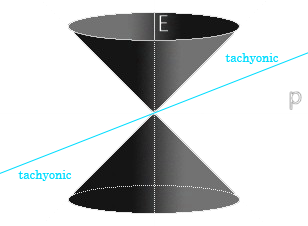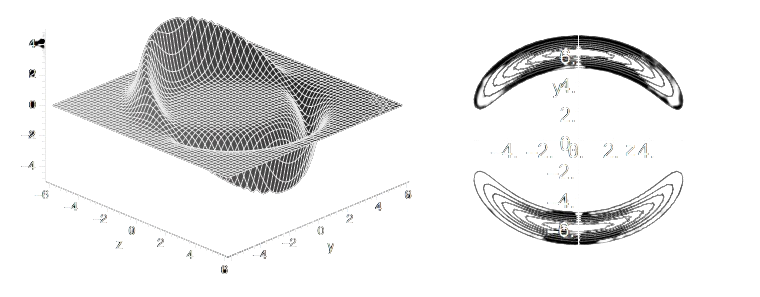Traversable Wormholes
Page Under Construction (Update July 2025) |
|---|
With the acquisition of gravity control technologies by using magnetic monopoles from the Tau Ceti star system, traversable wormholes became a reality. That is, devices capable of conveying persons, equipment, and information across interplanetary distances, seeming to travel faster-than-light (FTL), even though nothing is locally moving FTL. Unfortunately, warp drives are currently impossible and will remain that way for the foreseeable future.
Wormhole generators create wormholes on the spot, forming a wormhole connecting itself to another wormhole generator. That is, wormholes can only be formed between active generators. If a location doesn't want to form a wormhole with someone, it can block that mode of access.
Artificial wormholes are created and maintained through a careful balancing act between opposing tendencies of gravity. First, there is the self-attractive nature of classical gravity, trying to close off any wormhole (and form singularities in black holes). This is countered by a stronger negative pressure from the quantum mechanical nature of gravity (which prevents the formation of singularities), keeping the wormhole taut and traversable.
Terminology
Throughout this article the phrase 'hyperfast travel' is used instead of the phrase 'faster-than-light travel'. This is to reflect the original inspiration behind spacetime shortcuts rooted in General Relativity: they provide effective but not genuine FTL travel. Hence the term 'hyperfast' is used, as coined by Miguel Alcubierre in 1994.
The phrase 'quantum metric pressure' was coined by scientists in the Tau Ceti system to describe a phenomenon that is (1) not a pressure sourced by matter fields but by the very geometry of spacetime itself, and (2) a pressure resisting the breakdown of that geometric nature of spacetime into singularities or other pathological structures.
When the speed of light (c) is mentioned, it always refers to the speed of light in the vacuum, unless stated otherwise. It is the vacuum velocity that is invariant and sets the bounds on causal propagations and particles. Furthermore, all equations discussed assume c = 1.
Wormhole Technologies
Futuron developed wormhole technology in the Tau Ceti star system, first with microscopic wormholes that transmitted information, then eventually macroscopic generators that could transport people and eventually spacecraft. Like with any other gravity control technology, monopolium is a necessary ingredient in the generation of wormholes. As stated earlier, all wormhole generators require consent to connect: if the flare-out condition (i.e., ρ + p < 0) is not met on both sides, the wormhole will not form.
Quantum Channel
The first practical use of traversable wormholes was at the microscopic scale, for the transmission of energy and information that in principle could not be intercepted.
To Be Completed . . .
Gravity Gate
To Be Completed . . .
Physics of Hyperfast Travel
Flux Energy Condition (FEC)
As a corollary of Special Relativity and Quantum Field Theory, superluminal propagations and tachyonic particles are forbidden. This can be taken to imply that no transfer of a material's momentum (i.e., its pressure) can be of a greater magnitude than its energy density (ρ² ≥ p²). This rule was referred to as the Flux Energy Condition (FEC), which if true would have prohibited all hyperfast travel metrics. The FEC can be intuitively grasped in that, it posited that one cannot offload onto gravity the work of passing through spacetime faster than what is allowed by Special Relativity.
However, after the ESAS Cetus reached the Tau Ceti star system and examination of magnetic monopoles began, it was discovered that the geometry of spacetime can itself exhibit a tension (i.e., negative pressure) powerful enough to halt the inward collapse of a black hole into a singularity. That is, harnessing this quantum metric pressure allowed for the creation and stabilization of traversable wormholes in the Tau Ceti system.
Tachyons in Special Relativity
Just by looking at the math of Special Relativity, while nothing with real positive mass (like ourselves) can reach or surpass lightspeed locally, if one envisions a particle with a negative mass squared term (-m², or an imaginary invariant mass, √-1) these "tachyons" always travel FTL or have spacelike worldlines. While the mathematics of Special Relativity allow for such bizarre phenomena, Quantum Field Theory does not. In the interest of understanding the Flux Energy Condition, let's look at some of the bizarre behavior of superluminal tachyons anyway, relying only on Special Relativity.
Let's make use of the energy-momentum relation from Special Relativity (E² - p² = m², where p is momentum), where for particles with positive real mass always include the (spatial) momentum as part of their total energy density (E² = p² + m²). For massless particles, their energy is equal to their momentum (E² = p²). What of superluminal particles, or spacelike tachyons with a negative mass squared term (-m²)? Well, the momentum is greater than the total energy density (E² - p² < 0). This again confirms the spacelike nature of tachyons, since there is a spacelike or superluminal flow of momentum. So, we can map these relationships in terms of a space-time diagram, where E represents the temporal axis, and p represents a spatial axis. Causality is bounded into the past and future "light-cones" (the top and bottom shaded regions of the diagram below), with the superluminal "elsewhere" outside of the light-cones (transparent right and left regions). Let's summarize:
- Timelike or Real Mass: E² > p²
- Lightlike or Massless: E² = p²
- Spacelike or Tachyonic: p² > E²
The sequence of spacelike separated events is frame-dependent. Meaning, what appears as a positive energy tachyon moving forward in time, in another frame of reference, appears as a negative energy tachyon moving backwards in time. So, what is a tachyon emitter in one frame of reference is a tachyon receiver in another. Causality only holds within light-cones (where E² ≥ p²).
Let's examine another key component of the math of Special Relativity: the Stress Energy Tensor (Tμν). The Stress Energy Tensor mathematically "maps" the energy-momentum distribution in spacetime. The four-by-four matrix below accounts for this distribution across time and our three spatial dimensions (0, 1, 2, 3), such that one can translate between different frames of reference while preserving the same properties and laws of physics (i.e., Lorentz Invariance).
It is typical to interpret the components of the Stress Energy Tensor in the terms of a perfect fluid, allowing one to import the relations above regarding energy and momentum. So, 'ρ' is the relativistic energy density (the time-time component or T00) and each 'pn' is the pressure or the spatial momentum flux perpendicular to each spatial dimension:
- Timelike Flux: ρ² > pn²
- Lightlike Flux: ρ² = pn²
- Spacelike Flux: pn² > ρ²
One should now be able to see that there are certain "energy conditions" implied by these correlations within the mathematics of Special Relativity. By invoking the equivalence of inertial mass and gravitational mass, the Stress-Energy Tensor becomes the source of spacetime curvature in General Relativity. It must be noted, that the relationship between the metric tensor (gμν) and the Stress-Energy Tensor (Tμν) is highly nonlinear. This relation between spacetime geometry and energy-momentum distribution imputes relativistic energy conditions to General Relativity. Now, to Quantum Field Theory's understanding of tachyons.
No Superluminal Tachyons
Quantum fields with a negative mass squared term, tachyonic fields, do not have localized excitations that propagate at superluminal speeds (i.e., no superluminal particles). Instead, tachyonic fields are a vacuum instability, and decay through an exponential cascade of energies into a (more) stable vacuum. This aspect of Quantum Field Theory was confirmed in 2013 with the discovery of the Higgs Boson at CERN, since tachyon condensation is the mechanism by which the Higgs field potential reached its current Vacuum Expectation Value of 246 GeV. Since every particle is an excitation of a quantum field, and not even tachyonic fields have superluminal excitations, we can say with confidence that Quantum Field Theory forbids superluminal behavior.
Tachyonic fields have other restrictions in Quantum Field Theory. For example, a tachyonic field must be a scalar or spin-0 field. To allow for higher spin would preclude the field from having a negative mass squared term (i.e., -m²), and would cease to be tachyonic entirely.
We can finally express our energy condition, the Flux Energy Condition (FEC), in as a rule for perfect fluids: ρ² ≥ p². That is, if this inequality is violated, one then has an energy-momentum distribution where pressure propagates momentum at superluminal velocities. The FEC was physically equivalent to asserting that the speed of sound cannot be superluminal. That is, pressures and their disturbances must obey relativistic limits. However, while the inequality from the energy-momentum relation (E² ≥ p²) holds strictly for every on-shell or every real particle, it is inapplicable to the geometry of spacetime (not to be confused with gravitational radiation, which does obey the energy-momentum relation).
Quantum Metric Pressure
Although spacetime is not subject to the Pauli Exclusion Principle, spacetime exhibits a negative gravitational pressure at the Planck scale. The geometry of spacetime is described in General Relativity with metrics. So, unlike every other gravitational effect, which is a consequence of some distribution of stress-energy, this effect is a product of the quantum mechanical nature of the geometry itself.
In nature, this quantum pressure is responsible for a repulsive gravitational effect that stops the inward collapse of matter into singularities. While black holes still form with their event horizons, the interior structure of black holes diverge from the predictions of General Relativity where the inner Cauchy horizon forms, in rotating and charged black holes. Instead of a pathological region with timelike singularities, this quantum metric pressure prevents the collapse of black holes beneath an inner horizon. Note: the inner Cauchy horizon of some astrophysical black holes are macroscopic (kilometers in radius), so this quantum metric pressure becomes a macroscopic manifestation of Planck scale physics.
It would be a mistake to say this pressure occurs within spacetime, as one would with any matter or radiation field. Rather, this negative metric pressure is spacetime itself, when pushed into extreme configurations. In other words, quantum metric pressure is spacetime affecting itself directly. That is, at the Planck scale, the non-linear nature of gravity as curved spacetime results in curved spacetime affecting curved spacetime (gravity is self-interacting at these scales). So, this negative pressure is a feature of spacetime itself which means it not only can violate the FEC but it must violate the FEC, if it is to halt singularity formation.
While quantum metric pressure is well suited for forming and sustaining traversable wormholes, it is incapable of producing stand-alone negative energy densities. That is, the negative energy densities associated with quantum metric pressure in accelerated frames of reference are small and purely geometric in nature: it cannot be extracted to do work. These energy densities result as a side phenomenon that arises when one is not at rest relative to a region with quantum metric pressure.
Hyperfast Travel Schemes
Traversable Wormholes
That traversable wormholes require the dominance of repulsive gravitation can be easily understood with the following analysis. Normally, positive mass-energy warps spacetime such that light-rays converge after passing near a massive object (e.g., a star). However, light-rays initially parallel inside a spherical wormhole's throat must diverge upon exiting: repulsive gravity is what keeps a wormhole open or traversable (i.e., Raychaudhuri's Theorem). That is, a wormhole is made traversable by the dominance of a repulsive gravitational effect along their radial (r) coordinate. Without this negative radial pressure or radial tension (-p = τ), wormholes will close or "pinch off" faster than lightspeed particles could ever traverse them.
It's important to note that there were already regions of repulsive gravity within all black hole metrics except the Schwarzschild metric, but these were sourced and offset by an equal positive energy density (e.g., the angular momentum that exerts a repulsive gravity below the inner Cauchy horizon of the Kerr metric has a positive energy density, same for the electric charge of the Reissner–Nordström metric). Hence, black holes were never traversable wormholes. Truly traversable wormholes need an overwhelmingly negative radial pressure (p < -|ρ|), which in some accelerated frames of reference the energy density also becomes negative (ρ < 0). See the flare-out condition below, note: the zero subscripts mean these are various values at the center of the wormhole's throat (ℓ0).
Now, by simply looking at the exoticity function from Morris-Throne's 1988 paper (above), we can tinker with the values such that the magnitude of the pressure can be significantly reduced and remain traversable when the energy density is allowed to be negative (ρ < 0) in the wormhole's rest frame. While not noticeable from the formula above, allowing a negative energy density also allows one to significantly shrink the volume of the exotic material required to create and sustain a wormhole, making practical traversability easier to attain.
However we warn against attempts to avoid FEC violations by shifting the burden onto a large negative energy density, as an alternative approach to satisfying the flare out condition. This ignores the context we've described surrounding wormholes and black holes. Without violating the FEC, one has an unstable wormhole: even the slightest perturbation will cause the wormhole to pinch off and collapse, as the repulsive gravitation is too generalized.
The role of a negative radial pressure is highlighted by looking at the exoticity function as the energy density approaches zero (limρ → 0 ζ = ∞). That is, a wormhole with a vanishing energy density allows for even the smallest amounts of negative radial pressure to push exoticity (ζ) to infinity. A wormhole will not be traversable unless the flare-out condition is fulfilled in virtue of an excessive radial tension. The negative stress-energy must cancel out attractive gravitation in a very specific way to keep a wormhole traversable.
Superluminal Warp Drives
The first warp drive metric, by Alcubierre, works by relocating a "bubble" of spacetime by expansion at the back of the bubble and contraction at the front of the bubble. The negative energy density in the bubble's walls are perpendicular to the direction of motion. That is, perpendicular to the expansion and contraction. This means that where the magnitude of the energy density is largest, the metric obeys the Flux Energy Condition. Yet, where the expansion and contraction become their strongest in the direction of motion, there is a minimal energy density and thus, an overwhelming positive or negative pressure (p² > ρ²), the sign of the pressure depending on whether it is the expansive or contractive end.
While warp drive metrics have been constructed that avoid the expansion/contraction dynamic, the pressures at the front and back ends still exceeds the energy densities' magnitudes there. Like with wormholes, one may be tempted to rely on an overwhelming negative energy density and bypass FEC violations. However, the situation with warp drives is even worse than that of wormholes.
Without excessive anisotropic pressures (p < -|ρ|, at one end of the warp bubble and |ρ| < p, at the other end), the warp field will not be propulsive. Yes, negative stress-energies (ρ + p < 0) are required to have the repulsive gravity to make spacetime move counter to its normal tendencies. However, a negative energy density (ρ < 0) merely allows the warp bubble to keep up with the superluminal pressures (p² > ρ²). This is evident by comparing the left diagram in the above image (asymmetric spacetime curvature) with the right diagram (symmetric distribution of negative energy density). The negative energy density does absolutely nothing on its own: it merely provides the means to accelerate to "warp speed" without needing propellant (since rocket propulsion cannot enable hyperfast travel).
So, superluminal warp drives require both a violation of the Flux Energy Condition (at both ends of the warp bubble) and an absolutely negative energy density throughout the entire warp bubble's walls. Quantum metric pressure cannot source the astronomical negative energy densities needed for warp acceleration, and cannot generate the excessively positive pressure for that half of the warp bubble as well.
Plausibility of Schemes
While quantum metric pressure violates the FEC, and thus is able to hold open wormholes, regions with this negative pressure will be observed as possessing a negative energy density in accelerated frames of reference. Given the high exoticity value (ζ) of a traversable wormhole, it is very likely that any traveler through the wormhole will not be at rest relative to that wormhole, and will observe a negative energy density, no matter how miniscule.
Several things of note: these negative energy densities do not destabilize the vacuum since it is sourced by neither matter nor radiation, but is a feature of spacetime curvature itself. Since this pressure is the geometry of spacetime resisting its own collapse into pathological structures (e.g., singularities), no extraction of energies can take place. Otherwise, it would be a "gravito-tachyonic aether," propagating disturbances faster than the speed of light (in virtue of p² > ρ²). So, no production of positive and negative particle pairs takes place: the vacuum is stable.
Furthermore, while these negative energy densities "strengthen" a wormhole, they are by no means necessary. Their magnitude is far too small for use in any warp drive scheme, and the pressure dynamics that makes the negative energy densities possible (i.e., isotropic radial tension with a negative energy density from relativistic effects) are incompatible with the dynamics of warp drive metrics (i.e., negative energy density as a source of propulsion and of highly anisotropic pressures). That is, while a negative energy density is a side effect of quantum metric degeneracy pressure and its use in wormholes, a negative energy density is the central feature of warp drives, in its use of asymmetric pressures. Hence, warp drives will remain impossible for the foreseeable future.
Epilogue: No Time Travel
Although one travels through spacetime (not merely space) using wormholes, quantum gravity prohibits the creation of closed timelike curves. That is, wormholes cannot be used as time machines, to return home when or before one left home, in accordance with Stephen Hawking's Chronology Protection Conjecture of 1992 (confirmed in the Tau Ceti star system). If a wormhole or pair of wormholes enter a configuration where closed timelike curves can appear, the wormhole(s) will be destroyed by a cascade of vacuum energy equivalent to the mass-energy of the wormhole(s).
References
General Physics
Original Usenet Physics FAQThe Physics Stack Exchange
Hyperfast Travel
Morris-Thorne Wormhole (1988)Hawking Chronology Protection Conjecture (1992)
Alcubierre Warp Drive (1994) / (Free Version)
Wormholes and Scalar Fields (2000) / (Free Version)
Natário Warp Drive (2002) / (Free Version)
Wormholes Limρ → 0 ζ (2003) / (Free Version)
The Flux Energy Condition (2011) / (Free Version)
Loop Quantum Gravity: Planck Stars (2014) / (Free Version)
Wormholes, Warp Drives and Energy Conditions (2017) ADM Mass and Warp Drives (2023) / (Free Version)
Warp Factory Analyses of Warp Metrics (2024) / (Free Version)
Warp Factory Subluminal Warp Metric (2024) / (Free Version)








